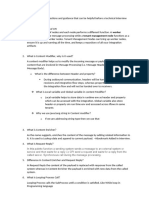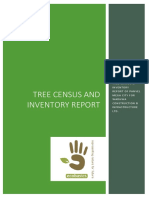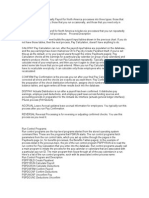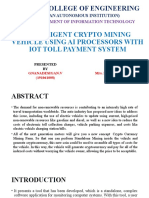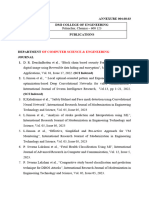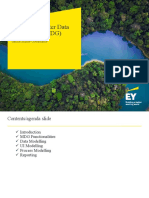SAP CPI Interview Ques ons – AnubhavTrainings.
com
Course page – h ps://www.anubhavtrainings.com/cloud-pla orm-integra on-training
Q: What is SAP CPI? A: SAP CPI (SAP Cloud Pla orm Integra on) is an integra on pla orm provided by
SAP that enables the seamless integra on of various systems and applica ons.
Q: What are the key features of SAP CPI? A: Some key features of SAP CPI include pre-packaged
integra on content, connec vity op ons, data mapping, monitoring, and security.
Q: How does SAP CPI handle connec vity to different systems? A: SAP CPI provides pre-built adapters
and connectors for various systems, such as SAP S/4HANA, Salesforce, SuccessFactors, etc., allowing
seamless connec vity and integra on.
Q: What is an integra on flow in SAP CPI? A: An integra on flow in SAP CPI represents a set of steps that
define how data is processed and exchanged between systems.
Q: How can you monitor integra on flows in SAP CPI? A: SAP CPI provides monitoring capabili es
through its web-based monitoring dashboard, where you can track the status, errors, and performance
of integra on flows.
Q: What is a message mapping in SAP CPI? A: Message mapping in SAP CPI is the process of transforming
and mapping data from one format to another during integra on.
Q: Can you explain the concept of content-based rou ng in SAP CPI? A: Content-based rou ng in SAP CPI
allows you to route messages based on their content, such as message headers, proper es, or payload
data.
Q: How do you handle errors and excep on handling in SAP CPI? A: SAP CPI provides error handling
mechanisms, such as excep on subprocesses, fault messages, and error queues, to handle errors and
excep ons during integra on.
Q: What is the significance of iflow in SAP CPI? A: An iflow (integra on flow) in SAP CPI represents a
specific integra on scenario or process that defines the flow of data between systems.
Q: How do you deploy integra on flows in SAP CPI? A: Integra on flows in SAP CPI can be deployed
either manually or automa cally using the SAP CPI web-based tools or through CI/CD pipelines.
Q: Can you explain the concept of content conversion in SAP CPI? A: Content conversion in SAP CPI
involves conver ng data from one format to another, such as XML to JSON or vice versa, to ensure
compa bility between systems.
Q: What are the different types of mappings available in SAP CPI? A: SAP CPI supports various mapping
techniques, including graphical mapping, XSLT mapping, and Java mapping.
�Q: How can you handle security and authen ca on in SAP CPI? A: SAP CPI provides authen ca on
mechanisms like OAuth, Basic Authen ca on, and SAML to ensure secure communica on and data
exchange between systems.
Q: What is the purpose of a value mapping in SAP CPI? A: Value mapping in SAP CPI allows you to map
and transform values between different systems, ensuring consistency and compa bility during
integra on.
Q: Can you explain the concept of request-reply in SAP CPI? A: Request-reply in SAP CPI refers to the
ability to send a request message to a system and receive a response back, enabling synchronous
communica on between systems.
Q: How does SAP CPI handle large volume data processing? A: SAP CPI provides mechanisms like
pagina on, parallel processing, and message spli ng to handle large volumes of data during integra on.
Q: What is an integra on package in SAP CPI? A: An integra on package in SAP CPI is a logical container
that groups related integra on flows and ar facts together for easier management and deployment.
Q: How can you schedule integra on flows in SAP CPI? A: SAP CPI allows you to schedule integra on
flows using its built-in scheduling capabili es, enabling automated execu on at specific mes or
intervals.
Q: What is the difference between sender and receiver adapters in SAP CPI? A: The sender adapter in
SAP CPI is responsible for receiving messages from the source system, while the receiver adapter is
responsible for sending messages to the target system.
Q: How can you handle message persistence and guaranteed delivery in SAP CPI? A: SAP CPI ensures
message persistence and guaranteed delivery through its message persistence mechanism, which stores
messages un l they are successfully processed.
Q: Can you integrate SAP CPI with on-premise systems? A: Yes, SAP CPI provides connectors and agents
that allow integra on with on-premise systems securely.
Q: What is the role of the integra on flow template in SAP CPI? A: Integra on flow templates in SAP CPI
are reusable templates that define the structure and logic of an integra on flow, allowing for rapid
development and standardiza on.
Q: How can you handle data mapping between different systems in SAP CPI? A: SAP CPI provides
mapping tools and func ons to define data mappings between different formats, such as XML, JSON, or
flat files.
Q: What is the purpose of the message monitor in SAP CPI? A: The message monitor in SAP CPI allows
you to track the processing status of individual messages, view error details, and reprocess failed
messages.
Q: Can you explain the concept of dynamic configura on in SAP CPI? A: Dynamic configura on in SAP CPI
allows you to dynamically configure integra on flow proper es and values at run me based on message
content or system variables.
�Q: How can you handle message rou ng and spli ng in SAP CPI? A: SAP CPI provides rou ng capabili es,
such as content-based rou ng and mul cast, to route messages to different target systems or split them
into mul ple messages.
Q: Can you describe the error handling process in SAP CPI? A: The error handling process in SAP CPI
involves defining error subprocesses, catching and handling excep ons, logging errors, and triggering
appropriate ac ons.
Q: How can you ensure the scalability and performance of integra on flows in SAP CPI? A: SAP CPI offers
scaling op ons, such as horizontal scaling and mul -node clusters, to ensure high availability,
performance, and scalability of integra on flows.
Q: Can you integrate SAP CPI with non-SAP systems? A: Yes, SAP CPI provides adapters and connectors to
integrate with a wide range of non-SAP systems, including popular cloud applica ons and databases.
Q: What is the purpose of the message mapping editor in SAP CPI? A: The message mapping editor in
SAP CPI allows you to define and configure data mappings between different structures or formats using
graphical mapping techniques.
Q: How can you handle data transforma on in SAP CPI? A: SAP CPI provides transforma on capabili es,
such as XSLT transforma ons and built-in func ons, to transform data between different formats and
structures.
Q: Can you explain the concept of error escala on in SAP CPI? A: Error escala on in SAP CPI involves
escala ng errors or excep ons to a higher level or external system for further processing or resolu on.
Q: How can you secure sensi ve data during integra on in SAP CPI? A: SAP CPI provides encryp on
mechanisms, secure channels, and data masking techniques to ensure the security and confiden ality of
sensi ve data during integra on.
Q: Can you perform message enrichment in SAP CPI? If yes, how? A: Yes, SAP CPI allows message
enrichment through various techniques such as content enricher, data lookup, or invoking external
services to enhance message content.
Q: What is the purpose of an integra on flow group in SAP CPI? A: An integra on flow group in SAP CPI is
a logical container that allows you to group related integra on flows together for easier management
and monitoring.
Q: How can you handle message sequencing and synchroniza on in SAP CPI? A: SAP CPI provides
techniques such as correla on IDs, sequence numbers, and synchroniza on primi ves to ensure
message sequencing and synchroniza on between systems.
Q: Can you explain the concept of error handling pa erns in SAP CPI? A: Error handling pa erns in SAP
CPI are predefined pa erns or templates that provide best prac ces for handling different types of errors
and excep ons during integra on.
Q: How does SAP CPI support message transforma on using XSLT? A: SAP CPI provides an XSLT mapping
editor that allows you to define XSLT transforma ons to transform XML messages between different
formats and structures.
�Q: Can you integrate SAP CPI with cloud-based applica ons? A: Yes, SAP CPI provides connectors and
adapters to integrate with various cloud-based applica ons, including Salesforce, ServiceNow, and
Microso Azure.
Q: How does SAP CPI handle system-to-system communica on protocols? A: SAP CPI supports various
communica on protocols such as HTTP, HTTPS, FTP, SFTP, and AS2 to facilitate system-to-system
communica on and data exchange.
Q: Can you explain the concept of a message flow in SAP CPI? A: A message flow in SAP CPI represents
the path that a message takes through the integra on flow, including rou ng, transforma ons, and
processing steps.
Q: How can you handle batch processing and batch spli ng in SAP CPI? A: SAP CPI provides batch
processing capabili es, such as batch steps and batch spli ng, to handle large volumes of data
efficiently during integra on.
Q: What is the purpose of the SAP CPI Eclipse-based development environment? A: The Eclipse-based
development environment in SAP CPI provides a rich set of tools and features for designing, developing,
and deploying integra on flows.
Q: Can you explain the concept of error propaga on in SAP CPI? A: Error propaga on in SAP CPI involves
propaga ng errors or excep ons from one integra on step to another or between integra on flows for
centralized error handling.
Q: How does SAP CPI support message transforma on using Java mapping? A: SAP CPI allows you to
develop custom Java mapping programs that can be used to transform messages between different
formats and perform complex data manipula ons.
Q: Can you integrate SAP CPI with legacy systems? A: Yes, SAP CPI provides adapters and connectors to
integrate with various legacy systems, such as SAP ECC, SAP PI/PO, and flat file-based systems.
Q: What is the purpose of the SAP CPI message log? A: The SAP CPI message log provides a centralized
repository for storing and viewing integra on flow messages, allowing easy tracking and
troubleshoo ng.
Q: How can you handle message aggrega on and de-duplica on in SAP CPI? A: SAP CPI provides
aggrega on and de-duplica on mechanisms to combine mul ple messages into a single message or
eliminate duplicate messages during integra on.
Q: Can you explain the concept of endpoint security in SAP CPI? A: Endpoint security in SAP CPI involves
securing the integra on endpoints, such as APIs, web services, or system connectors, to prevent
unauthorized access or a acks.
Q: How does SAP CPI handle data transforma on using graphical mapping? A: SAP CPI's graphical
mapping editor allows you to visually define mappings between source and target structures by drag-
and-drop, func on mapping, and value mapping techniques.
These ques ons cover various aspects of SAP CPI, including integra on flows, data mapping, error
handling, security, performance, and integra on with different systems. Use them as a star ng point for
your SAP CPI interview prepara on.






























